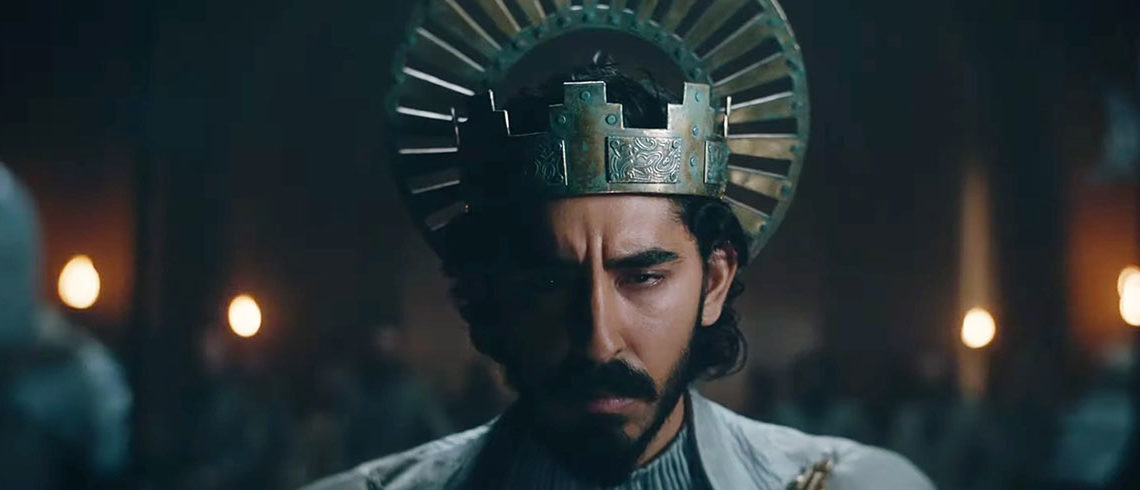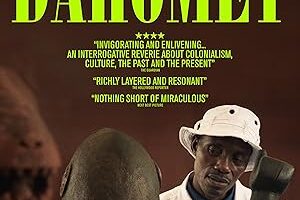Tropic Sprockets / The Green Knight
By Ian Brockway
From the inimitable David Lowery (A Ghost Story), “The Green Knight” is a stunningly visual and dream-like adaptation of the 14th Century narrative poem Sir Gawain and The Green Knight. The poem is about many things, but most profoundly it centers on the cycle of life and death and the nature of change.
Lowery’s film is challenging, opaque and startling in keeping with his style. It is also complex and moody. Its melancholic attitude rejects easy explanations. It is in many ways an interpretation although it is quite faithful to the source material.
Gawain (Dev Patel) is huddling as if from a nightmare. A tower in the distance is on fire. Several livestock are in an uproar. It is Christmas Day. Gawain rises hurriedly. Fleshy bodies whirl around him coupled with orgasmic cries.
Gawain arrives at the hall of King Arthur (Sean Harris) and a severe Queen (Kate Dickie). The King asks for a Christmas story. Gawain apologizes having nothing to offer. The King suggests, in that case, to be humored with a game. A formidable creature then enters mounted on a huge black horse. It is the half man, half tree, organic creation The Green Knight (Ralph Ineson).
Suddenly the queen becomes spiritually possessed by The Green Knight. Her eyes milk over and she speaks in a deep devilish voice. She explains that a contest is requested: a man must take a sword and strike a blow to the fearsome thorny Green Knight. Gawain accepts the challenge. After some perspiration and deep breathing, Gawain beheads the Green Knight as easily as chopping a head of broccoli. In the manner of Irving’s The Legend of Sleepy Hollow, the knight’s head is taken by the now headless man, and he exclaims there will be a meeting at the Green Chapel in a year’s time.
Gawain thinks it a joke. Little does he know, he has begun his journey to The Green Chapel, right after he severs the knight’s head. Events grow increasingly eerie in the manner of Lars von Trier. Trees appear bent at impossible angles. Buildings smolder with a black Satanic ash and Gawain is often unheard or misunderstood. Gawain has a talking fox to accompany him on his journey, reminiscent of Trier’s “Antichrist,” though a fox is given in the original text.
There is a smarmy youngster (Barry Keoghan) who is horribly sarcastic to Gawain as he robs him. When Gawain reaches the crest of a hill, he is confronted with giant alien humanoids who appear to either pity him or think him insignificant.
At times Gawain gets into trouble a bit like hapless Pinocchio. But the errant knight is also distant. He doesn’t seem to love his girlfriend Essel (Alicia Vikander) but when the Lady of the house appears under a witchy spell (also played by Vikander) his green sash is more than aroused. Often he seems Kafka-like, pale and removed from existence, going through the motions, resigned to happenstance. When he agrees to have his portrait done, it is morose and green, a reptilian Dorian Gray.
Though Gawain is bound by honor, he is oddly passive. One wonders if he has not lost his head already. In one striking scene Gawain as King appears to be watching an overplayed film of his life onscreen as his castle crumbles in a bile green hue around him. A projection from the Apocalypse.
Though it is not necessary to have read the original poem, it will give some added perspective and understanding.
Though this film employs frequent shapeshifting and is hard to follow, “The Green Knight” contains dazzling thematic images that make it cohesive. Given Gawain’s passivity and his endless fevers of gold and green, the film has a rhythm all its own and is in itself, a poem, enigmatic and eccentric.
Write Ian at [email protected]
[livemarket market_name="KONK Life LiveMarket" limit=3 category=“” show_signup=0 show_more=0]





No Comment